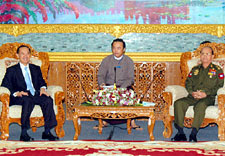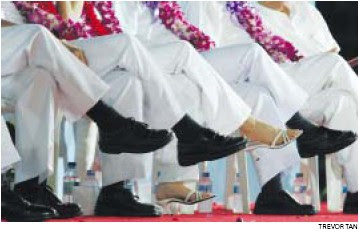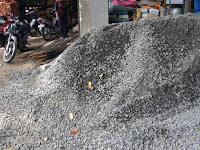It seems that the Singaporean and Malaysian governments have taken on a whole new meaning to “bilateral cooperation” by aping each others’ moves in banning political films.
Just 3 weeks ago, the Malaysian government turned down the appeal by filmmaker Amir Muhammad against the ban on his film about Malay communists, Apa Khabar Orang Kampung (The Village People Road Show). The Malaysian government cited, among other things, that the film “blatantly” criticises the Malaysian government and it “shows the opinions and stories only of the communists”. This came barely a year after the Malaysian Home Affairs Ministry banned the film, Lelaki Komunis Terahkir (The Last Communist), a film about former Malayan Communist Party chief Chin Peng, under their Film Censorship Act. Interestingly, that film was passed without any cuts by the National Film Censorship board in March 2006 but the Home Ministry retracted the approval ten days before film was scheduled to start screening.
In an almost copycat move, the Singapore Ministry of Information, Communications and the Arts (MICA) has just banned local filmmaker Martyn See’s film, Zahari’s 17 Years. The scenarios couldn’t have been more similar. See’s film was about a former Malay newspaper journalist and opposition party president’s arrest and detention under the Internal Security Act on suspicion of “involvement in communist united front activities against the interest of Singapore”.
It is surprisingly coincidental that, just as in the case in Malaysia, See’s film was passed by the Board of Film Censors as “PG” for the Singapore International Film Festival, and now MICA has decided to backtrack and ban the film 3 weeks after the Malaysians banned Amir Muhammad’s film. The reason given by MICA is that it will “undermine public confidence in the Government”. The full text of MICA’s statement can be found on its press release yesterday.
While I hold no sympathy for the communist cause, I believe these alleged communists have served their time in jail (albeit without the benefit of an open trial) and they have lost their war. The harsh actions of the Government back then could in some ways be justified as we were facing an almost insurmountable threat to our nation’s security and survival. But now that the war on communism is over, the truth should be allowed to surface — including the stories from the other side of the fence. It is in the interest of Singapore that young Singaporeans be educated on what went on during those turbulent times in our nation’s history, and arrive at their own judgments.
To ban or not to ban
The Government’s moves and statements on political films appear to be inconsistent at best. In 2005, Martyn See was hauled up by the police for making a documentary about democracy activist Chee Soon Juan, Singapore Rebel. The film was banned on the basis that it was a “party political film” in contravention of the Films Act (Section 33). In an interview with Time magazine in December that year, Minister Mentor Lee Kuan Yew said in reference to Singapore Rebel: “Well, if you had asked me, I would have said, to hell with it. But the censor, the enforcer, he will continue until he is told the law has changed. And it will change…”. Not surprisingly, eight months later, the police completed their investigations on See and let him off with just a “stern warning”.
In January this year, in an interview on Channel NewsAsia’s BlogTV, Foreign Minister George Yeo, in response to a question by blogger Gayle Goh, said that he was “responsible for that peace of legislation” when he was Information Minister not to allow political videos and films. He said, “We did not want politics in Singapore to be trivialised and so commercial where it all depends on packaging and how much money you are able to put into producing a programme. So we decided keep it simple, keep it cheap.” However, he added that the Government “did not reckon this new media (the Internet) which allows you to produce the programmes quite cheaply. So I think we’ve got to adjust that position.” (Emphasis mine.)
Almost a year-and-a-half has passed since MM Lee’s “to hell with it” remarks and four months since George Yeo’s comment that “we’ve got to adjust that position” on political films. Yet there is still no news from MICA that the Section 33 of the Films Act will be repealed. Instead, this time MICA banned Zahari’s 17 Years using a different section of the Films Act — Section 35 (1) — for the first time. This section of the Act allows the MICA Minister to prohibit the possession or distribution of any film contrary to public interest. With effect from tomorrow, anyone who possesses or distributes the film could be fined up to $10,000 or jailed for a maximum of two years, or both. This sets an unsettling precedent on how MICA intends to regulate political films, even if Section 33 is repealed.
Will “Light touch” still hold?
Martyn See has said he will upload his film onto YouTube if the ban remains. It is unclear whether the government will act against citizens who view the film on YouTube. Does viewing YouTube video streams count as being “in possession” of the film, and will Martyn See be charged for “distribution” of the film? After all, YouTube clips cannot be saved on one’s hard disks, and lawyers might be able to argue over whether the act of uploading a film on YouTube counts as “distribution”, when in effect it is YouTube which is distributing the film via its website. In any case, just like See’s other film, Singapore Rebel, any one of his hundreds of fans overseas can easily upload their copy of the film onto YouTube, and there’s nothing the Government can do about it.
My hunch is that it is unlikely that the Government will want to follow the Thai government in banning YouTube or take any action against people who watch the YouTube clip (if it does get uploaded) in the privacy of their own homes, in light of their pledge to regulate the Internet with a “light touch”. But given the nature of Singapore’s legislation on the media, whereby “the Minister” is given wide-ranging discretionary powers to ban films, it could go either way.
****************************************************************
Film on ex-detainee banned
It may undermine public’s confidence in Govt: MicaLoh Chee Kong
cheekong@mediacorp.com.sgA FILM about a former journalist detained under the Internal Security Act has been deemed “against public interest” and banned by the Government.
Shot, directed and edited by local film-maker Martyn See, the 50-minute interview-based film, Zahari’s 17 years, centres around the February 1963 arrest and subsequent detention of Mr Said Zahari, a former editor of the Malay-language newspaper Utusan Melayu and president of Parti Rakyat Singapura. Mr Said, then 34, was arrested during Operation Cold Store — a Government security operation against subversive activities — and released in August 1979.
In a statement yesterday, the Ministry of Information, Communications and the Arts (Mica) said the film gives “a distorted and misleading portrayal” of Mr Said’s arrest and detention and was “an attempt (by Mr Said) to exculpate himself from his past involvement in communist united front activities against the interest of Singapore”.
The ministry said Mr See had submitted the film to the Board of Film Censors for classification for screening.
Explaining its decision to use, for the first time, section 35 (1) of the Films Act, Mica added: “The Government will not allow people who had posed a security threat to the country in the past, to exploit the use of films to purvey a false and distorted portrayal of their past actions and detention by the Government. This could undermine public confidence in the Government.”
Section 35 (1) allows the Mica Minister to prohibit the possession or distribution of any film contrary to public interest. With effect from tomorrow, anyone who possesses or distributes the film could be fined up to $10,000 or jailed for a maximum of two years, or both.
When contacted, Mr See, 38, said he found the decision “very strange”.
He said: “I had wanted to screen the film here, but I haven’t decided when and where yet … I need to find out on what basis they are banning it.”
This is the second time in as many years that a film which Mr See had directed has run afoul of the Films Act, which prohibits films with political themes. Last year, after 15 months of investigation, the police gave him a “stern warning” over his documentary about opposition politician Chee Soon Juan, which was banned under a different section of the Films Act.
Last year, Zahari’s 17 years was submitted for the Singapore International Film Festival. At that time, the Board of Film Censors passed the film with a PG rating — traditionally, films at the festival attract a smaller audience than at a general release. But despite the rating, the festival organisers decided not to screen the movie. It has, however, been shown at film festivals in Malaysia and Toronto.
“(The Board of Film Censors) has to explain why they had passed it under “PG” in the first place. If I’m not satisfied with the explanation, I will have to put it up on YouTube,” Mr See said.



